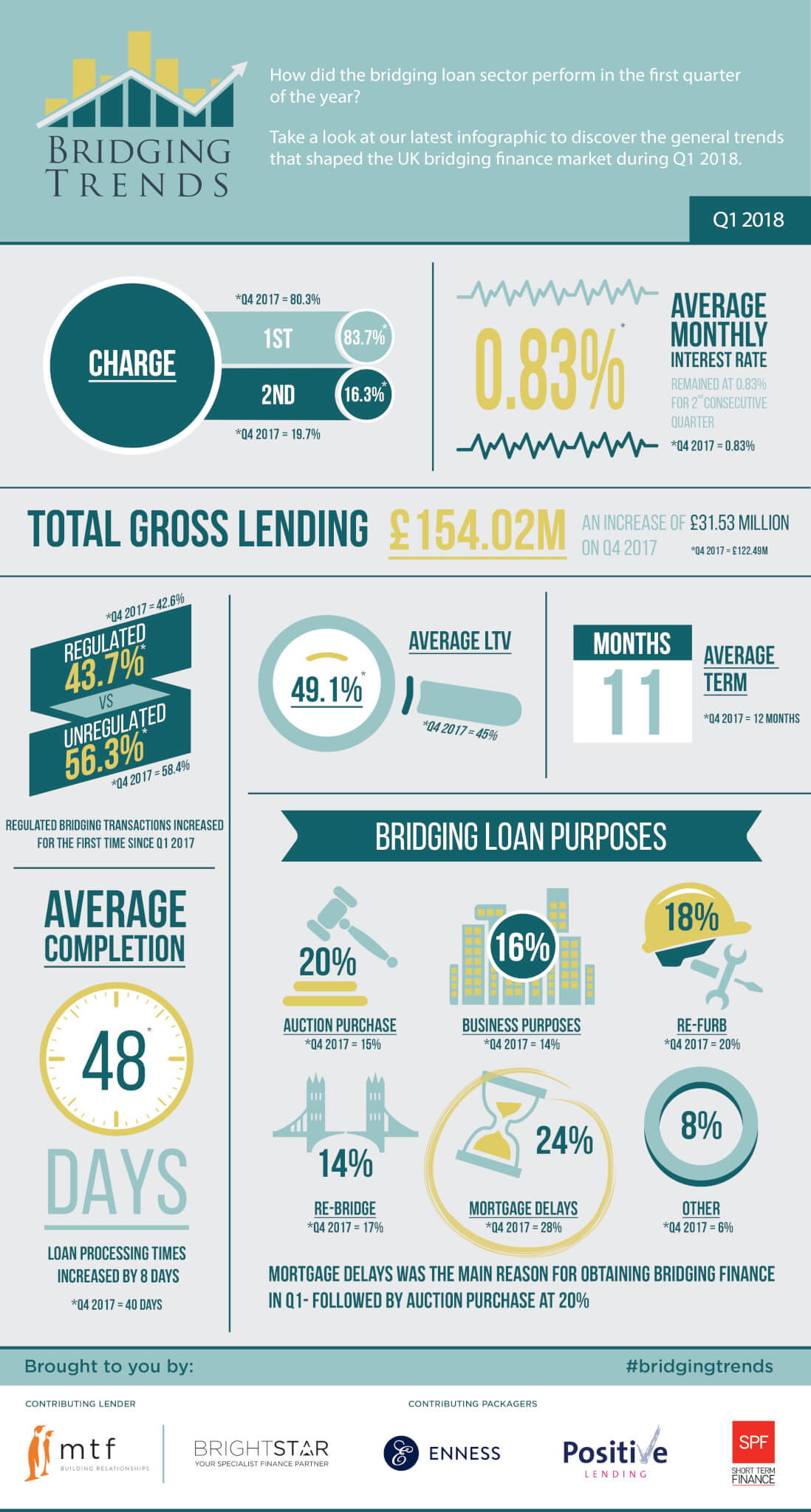bridging loan volume soars in Q1
Bridging lending hit highest level in the first quarter, according to the latest Bridging Trends data.
Bridging loan volume peaked at £154.02m in the first quarter of 2018, up almost a third compared to £118.79m for the same period last year, as demand for short-term finance continued to grow.
The year kicked off to a strong start and at £154.02m, the market experienced the highest volume recorded since Bridging Trends launched in 2015, almost doubling £80.47m of lending during Q1 2015.
Prior to Q1 2018, volume peaked at £150.07m during the second quarter of 2017.
Bridging Trends, a quarterly publication by short term finance provider mtf and specialist finance brokers Brightstar Financial, Enness, Positive Lending, and SPF Short Term Finance, launched to monitor general trends in the UK bridging finance market in a bid for greater transparency.
For the third consecutive quarter, mortgage delays were the most popular reason for obtaining a bridging loan, accounting for 24% of all lending.
For the first time, auction purchases were the second most popular reason for getting a bridging loan at 20% – up from 4% during the same quarter last year, as an increasing number of people benefitted from fast access to capital. Refurbishment was the third most popular reason for obtaining a bridging loan during the first quarter at 18%.
A completion time of 48 days during Q1 2018 was also lower than an average completion time of 50 days during Q1 2017.
The average term of a bridging loan was 11 months during the second quarter, down from 12 months in the previous quarter.
Average monthly interest rates remained at 0.83% for the second consecutive quarter and were 0.83% during the same quarter in 2017. Average Loan-To-Value (LTV) levels increased to 49.1% in Q1 2018, from 46.2% during the Q1 2017.
Regulated bridging loans increased for the first time since Q1 2017, with the number of regulated loans conducted by contributors increasing to 43.7% in Q1 2018, compared to 42.6% during Q4 2017.
First legal charge lending increased to 83.7% of all loans during Q1 2018, up from 80.3% in the fourth quarter. Meanwhile, second charge loans increased to 16.3% compared to 13.4% during Q1 2017.
Key data points from Bridging Trends in Q1 of 2018 are as follows:
- Contributor lending reaches record high at £154.02m
- Bridging loan demand peaks for auction purchases
- Average monthly interest rate holds steady at 0.83%
- Regulated bridging loans increase for the first time in a year
Joshua Elash, director of bridging finance lender, mtf, comments:
“It is particularly interesting that pricing has remained stable, despite an increase in regulated lending. This suggests that the recent downward pressure on rates might be easing and in the unregulated space, going the opposite way.
“Also, particularly interesting is the increase in bridging loans for auction purchases, considering the otherwise quiet property market, where transactional volumes have been adversely impacted by recent changes to buy-to-let income tax treatment and exorbitant increases in stamp duty.”
Tomer Aboody, director of bridging finance lender mtf, comments:
“Bridging volume has peaked to its highest level as the product becomes an increasingly mainstream financial tool. This is good news for borrowers that are able to access fast and vast pools of capital to fulfil their short-term funding needs as well as a growing number of investors attracted to the space.”
Chris Whitney, Senior Broker at Enness Commercial, comments:
“We’ve undoubtedly seen an increase in volume for bridging finance, but I also wonder if the breadth of lending that specialist lenders now provide is a contributory factor. For example, by definition, bridging loans are a short-term finance facility. However, that definition is now being stretched, with bridging lenders often able to offer facilities for up to two or even three years now.
“Lenders are also offering loans for more varied purposes, like ground-up development. We now even have Sharia-compliant facilities in our toolbox, allowing us to cater for a wider audience. Therefore, the increase in lending perhaps results from there being more things you can ‘do’ with bridging.
“I also think much of the increase in volume is outside of London and the South East, with other areas of the UK playing catch up from previous years. Again, this is because lenders are widening their nets, working across the UK and lending into the Republic of Ireland, Northern Ireland, Scotland, and so on.
“Ultimately, we may soon need to be having a conversation about what constitutes a bridging loan, in order to gain true insight into what the market is doing.”
To view the Bridging Trends Q1 2018 infographic, please visit www.bridgingtrends.com





